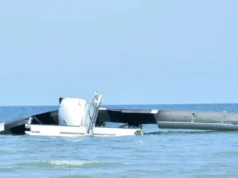By Chaminda Silva
Severe weather conditions over the past six days have affected 199 Divisional Secretariat areas in 23 Districts across Sri Lanka, resulting in 12 fatalities and the displacement of 335,155 individuals from 99,876 families as of midday yesterday (28), according to Pradeep Kodippili, Director of the Disaster Management Centre.
The fatalities include one each from Puttalam, Trincomalee, Badulla, and Vavuniya, as well as eight in Ampara. Among the deceased in Ampara were schoolchildren. Two other individuals are reported missing in the district.
Disasters have caused injuries to 17 people, completely destroyed 95 homes, and partially damaged 1,708 others. Emergency measures have provided shelter for 61,290 individuals from 18,025 families in the homes of relatives, while 27,717 people from 8,678 families have been accommodated in 279 safety centres.
The worst-affected areas include Ampara, where 149,491 individuals from 43,631 families across 20 Divisional Secretariat areas have been affected; Mannar, with 61,297 individuals from 18,642 families across five Divisional Secretariat areas and Jaffna, with 43,682 individuals from 12,970 families across 15 Dvisional Secretariat areas.
Significant rainfall was recorded in the 24 hours ending at 6:00 a.m. yesterday, with 132.75mm in Alkaduwa (Matale), 124mm in Holitrington (Kandy), 122mm in Kotmale (Nuwara Eliya), 96.75mm in Pussellawa (Kandy), 91mm in Tholpuram (Jaffna), 78.50mm in Muruthalawa (Kandy), 65.50mm in Nuwara Eliya, 131.50mm in Allappillai (Mullaitivu), and 76.50mm in Welioya (Mullaitivu).
The National Building Research Organisation issued landslide warnings for nine districts: Badulla, Colombo, Gampaha, Kandy, Kegalle, Kurunegala, Matale, Nuwara Eliya, and Ratnapura. Red alerts were issued for areas such as Medadumbara, Udunuwara, and Harispattuwa in Kandy; Aranayake and Mawanella in Kegalle; Ukuwela, Naula, and Wilgamuwa in Matale; and Walapane in Nuwara Eliya. Residents in these areas were advised to evacuate.
Water levels in several rivers and streams, including the Mahaweli, Heda Oya, Deduru Oya, Mundeni Aru, Malwathu Oya, Kala Oya, and Kelani Ganga, were reported to be rising. Kodippili urged residents in low-lying areas to remain cautious.
Flooding, fallen trees, and landslides were reported in Matara, Badulla, Polonnaruwa, Kurunegala, Anuradhapura, Nuwara Eliya, Batticaloa, Trincomalee, Jaffna, Mullaitivu, Vavuniya, and Ampara districts. A bridge near the 375km marker between Ampara and Mannar was reported to have collapsed.
Of the 73 major reservoirs under the Irrigation Department, 40 had opened sluice gates, while 50 of the 170 medium-sized reservoirs were spilling as of yesterday, according to Director of Irrigation Engineer S.T.C. Sugishwara.
To assist those affected, 2,773 personnel from the armed forces and police were deployed in 210 teams equipped with 239 boats. Additionally, six Air Force helicopters, 111 Unicorn vehicles, 40 tractors, and 64 army trucks were mobilised, while the Navy deployed 36 catamarans for rescue operations.
The low-pressure system in the Bay of Bengal intensified into a cyclone yesterday morning, located approximately 100km northeast of Trincomalee and moving slowly northwest towards the northern coast, said Meteorology Department Director General Athula Karunanayake.
Heavy cloud cover remains across the island, with rainfall exceeding 150mm expected in parts of the Northern Province and Trincomalee. Other areas, including the North Central, North Western, Matale, and Kegalle districts, may receive more than 100mm of rain in certain locations.
The cyclone is expected to move away from Sri Lanka in the coming days. Wind speeds could increase to 50-60km/h. Fishermen and naval personnel are advised to refrain from activities until further notice. Heavy rainfall is likely to decrease by tomorrow (30), though scattered showers in the evenings or nights are expected in some regions thereafter.








